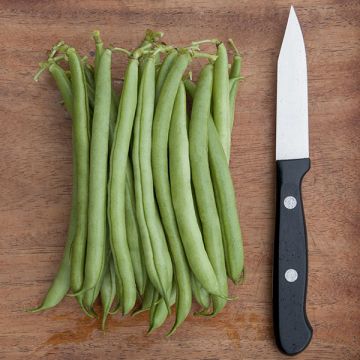
Phaseolus vulgaris
Mardi Gras Blend Bean
Days to Maturity: 55 days
SKU
2150
In stock
Starting at:
As low as
$3.75
Pre-mixed purple, yellow and green snap beans make an eye-catching custom blend.
No more hand mixing after a bean harvest our tri-color bean blend makes it easy and efficient to offer bags of colorful beans! Varieties selected for their excellent flavor and even rates of maturity. Plant successions and harvest these beautiful, festive beans all season. Includes gold, purple and green snap beans.
- HMOS EXCLUSIVE
- Open-Pollinated
- Matures evenly
- 4-6" pods
Cultural Info
Beans are tender annuals in the Leguminosae family, which also includes garbanzos, peas, lentils, and peanuts.
- Snap beans (Phaseolus vulgaris) – Most often green but sometimes gold or purple, these beans are eaten fresh, steamed or pickled within their succulent pod. Snap beans have both bush and pole growth habits.
- Dry beans (Phaseolus vulgaris) - These varieties are grown for the mature bean seed. Dry beans have both bush and pole growth habits.
- Fava beans (Vicia faba) - Plants are 2-3’ tall with an upright central stem, lovely foliage and striking white and purple flowers. They yield gigantic beans that can be eaten at the shell stage or dried for later use.
Soil and Nutrient Requirements
Beans only require average fertility and prefer pH in the 6.0 - 6.8 range. Choose well drained, warm soils and use inoculants to increase yields where natural Rhizobia populations are low.
Seeding Depth
1-2”
Plant Spacing
For bush beans, 2-3”
Row Spacing
For snap bush beans 18-36”, for bush dry beans 28-36”, for pole beans 6”; for pole beans use single or double rows, with 12” between, and 4’ center beds with trellis in the middle.
When to Sow
Days to maturity are from direct seeding. Direct seed after all danger of frost has passed. Optimal soil temperature for germination is 75-95°F. Beans are particularly sensitive to cool soils and are prone to rot if temperatures are below 55°F. White-seeded beans typically do not germinate as well as dark-seeded beans. Snap beans can be planted every 2-3 weeks for a continual harvest through mid-summer.
Other Considerations
When possible, wait for dry conditions before handling plants.
Pole beans require trellising for support. Plant in single or double rows, or a circle for a tripod trellis.
Harvest
Harvest early and often to increase yields. Remove oversized beans to maintain pod production. Dry beans are harvested once in the fall, when plants are drying down. Harvest by hand or machine, using either a combine or a stationary thresher. Avoid harvesting moldy pods whenever possible, and make sure beans are completely dry before threshing.
Storage
Dry further in cool, dry conditions prior to long-term storage. Beans are ready for storage when seed coat can not be dented by fingernail. Store beans in a cool dry place.
Pest Info
- Aphids can be washed off plants with a hard stream of water. They have several natural predators that control populations including parasites (aphids appear grey or bloated), lady beetle larvae and lacewings
- Seedcorn maggot is attracted by heavy applications of manure or organic matter which encourage egg laying.
- Leafhoppers are small wedge shaped insects that suck the juice from leaves rather than eating holes through them. If leaves are yellowing and curling under, examine the underside for leafhoppers. They overwinter in the Louisiana area and arrive with storm fronts in other parts of the country.
Disease Info
- Root rot, caused by several different soil-borne fungi, can be prevented by rotating with a cereal or pasture crop and by planting into soil temperatures above 60°F. Root rot is less of a problem where soil is warm and well-drained.
- White mold, Sclerotinia sclerotiorum, causes a pod and stem blight and is generally a disease of cool, damp conditions. Do not handle plants during wet conditions. Wider spacing can allow more aeration between plants and help control the spread of disease. White mold survives in soil and plant debris; therefore infected plants should be removed from the field. Dry beans and soybeans are not as susceptible to white mold as snap beans. Crop rotation is essential.







